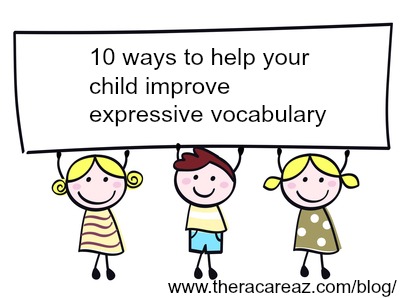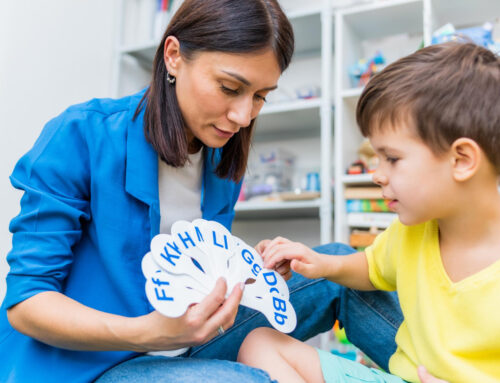
Expressive vocabulary is our ability to name/label items (and people) in our environment. While receptive vocabulary encompasses the words that we understand, expressive vocabulary refers to the words we produce. Children with special needs may or may not begin building an expressive vocabulary at the expected time developmentally, but this is a skill that you can help your child build, no matter where they are currently in their level of development. Expressive vocabulary can include any modality that your child uses to express himself, request, and label those things that are within their environment, be it words, word approximations, signs, or use of an AAC.
Here are 10 ways you can help promote expressive vocabulary building.
- Point to pictures in books and label the pictures for your child. This can be as simple as pointing to and labeling large pictures that are found in a board book, or naming pictures and talking about the story in a children’s picture book. If your child uses an AAC device, you can also find the corresponding icons on their device in addition to naming the pictures for them.
- Every time you hand an item to your child, say the name of that item. By naming each item for your child you are helping them build a receptive (understanding) vocabulary in addition to promoting expressive (labeling) vocabulary.
- Play with your child. Play is the foundation of language skills. If your child is not playing with toys yet, try a simple cause/effect toy to elicit interest. If your child is playing with toys, narrate what the toys are doing or narrate what you are doing with them.
- Use songs and fingerplays. Singing helps to promote automatic speech in addition to speech prosody. When your child attempts to hum or sing along, this enables them to join in a verbal activity, which is a precursor to speech.
- For names of animals, start with the sound that animal makes; for example, “Moo” is much easier for most children to produce than “cow”.
- Communicate face to face when possible. Get down to your child’s level so that they can see your face when you are talking to them or showing them an item.
- Expand on vocabulary your child already knows. If your child sees a bus and says “bus”, expand on this to “yellow bus”, If they say “dog”, expand on this and say “Yes, that is a big dog”, etc. This helps children learn modifiers (describing words) and build their expressive vocabulary beyond just nouns.
- Build one level up from where your child’s vocabulary is presently. If your child is using one word at a time, expand and model two word phrases. If your child is using two word phrases, also use two word phrases when playing with them, throwing in three word phrases during the play time.
- Read to your child. Books with brightly colored pictures help keep interest. If your child has a short attention span for listening to a story, you can shorten the text each page to accommodate your child’s attention level.
- Utilize other modalities of expression. If your child is not verbal yet, teach basic ASL signs (or sign approximations) for items/actions that are most important (highest motivation) for your child; for example, Mom, Dad, milk, etc. If your child has an AAC device incorporate it into reading/labeling activities.

 Katie Sullivan, M.S., SLP-CCC has been a pediatric Speech Language Pathologist for 22 years, and is a Therapy Supervisor with Theracare. She is the mother to five children, ages 7-17, including twin teenage sons with special needs. You can follow her at the My Sweet Homeschool blog, facebook, twitter, and instagram.
Katie Sullivan, M.S., SLP-CCC has been a pediatric Speech Language Pathologist for 22 years, and is a Therapy Supervisor with Theracare. She is the mother to five children, ages 7-17, including twin teenage sons with special needs. You can follow her at the My Sweet Homeschool blog, facebook, twitter, and instagram.





